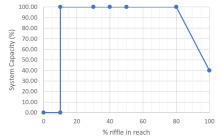Percent Riffle in Reach and Nooksack Dace
mbakken
View all records in the stressor response library
Species Common Name
Nooksack Dace
Latin Name (Genus species)
Rhinichthys cataractae
Stressor Name
Riffle
Specific Stressor Metric
Riffle in reach
Stressor Units
% of riffle in reach
Vital Rate (Process)
System capacity
Geography
Lower Fraser Valley (British Columbia)
Detailed SR Function Description
The shape and threshold for the final curve (10%) is based on Pearson et al. (2007) and Pearson (2004), which shows a large decline in percent reaches occupied by Nooksack Dace when percent riffle in reach in below 10%. The habitat suitability curve for Longnose Dace (Edwards et al. 1983) also supports the shape (a threshold response) of the function. The presumed ecological mechanism is that once riffle habitat declines below a minimum threshold (i.e., 10%) there is no longer sufficient habitat to support a large or continuous population, and riffles may be spatially isolated and unoccupied. based on expert opinion provided at the workshop held in November 2024, the originally proposed continuous declining response after threshold (10% riffle) was modified to a step response (Jordan Rosenfeld, Pers. Comm., 2024)
Function Derivation
Based on data from Nooksack Dace and Longnose Dace; Empircal data (Correlative model); Published; Expert opinion
Transferability of Function
As local adaptations are likely minimal among different Nooksack Dace populations, we would not expect much variation in true tolerance among populations. This function should therefore be broadly applicable to all populations of the species with caution.
Source of stressor Data
Percent riffle data is available for most (but not all) reaches in Bertrand, Pepin, Fishtrap Creeks, and the Salmon River, collected as part of Pearson (2004) and subsequent field work to define critical habitat for Nooksack dace.
Function Type
continuous
Stressor Scale
linear
References Cited
Usoof, A.M. and Rosenfeld, J.S. 2024. Relationship between system capacity and Percent Riffle in Reach for Nooksack Dace.
Edwards, E. A., H. Li, and C. B. Schreck. 1983. Habitat Suitability Index Models: Longnose Dace. U.S. Dept. Int., FishWildl. Serv. FWS/OBS-82/10.33.
Pearson, M. P. 2004. The ecology, status and recovery prospects of Noonsack dace (Rhinichthys Cataractae ssp.) and Salish sucker (Catostomus sp.) in Canada. University of British Columbia.
Pearson, M. P., T. Hatfield, J. D. McPhail, J. S. Richardson, J. S. Rosenfeld, H. Schreier, D. Schluter, D. J. Sneep, M. Stejpovic, E. B. Taylor, and P. M. Wood. 2007. Recovery Strategy for the Nooksack Dace ( Rhinichthys cataractae) in Canada. Species at. Fisheries and Oceans Canada, Vancouver B.C.
Edwards, E. A., H. Li, and C. B. Schreck. 1983. Habitat Suitability Index Models: Longnose Dace. U.S. Dept. Int., FishWildl. Serv. FWS/OBS-82/10.33.
Pearson, M. P. 2004. The ecology, status and recovery prospects of Noonsack dace (Rhinichthys Cataractae ssp.) and Salish sucker (Catostomus sp.) in Canada. University of British Columbia.
Pearson, M. P., T. Hatfield, J. D. McPhail, J. S. Richardson, J. S. Rosenfeld, H. Schreier, D. Schluter, D. J. Sneep, M. Stejpovic, E. B. Taylor, and P. M. Wood. 2007. Recovery Strategy for the Nooksack Dace ( Rhinichthys cataractae) in Canada. Species at. Fisheries and Oceans Canada, Vancouver B.C.
File Upload
Stressor Response csv data
Data_ND_PercentRiffle.csv
(224 bytes)
| Percent Riffle | System capacity (%) | SD | low.limit | up.limit |
|---|---|---|---|---|
| 0.00 | 0.00 | 0 | 0 | 100 |
| 10.00 | 0.00 | 0 | 0 | 100 |
| 10 | 100.00 | 0 | 0 | 100 |
| 30.00 | 100.00 | 0 | 0 | 100 |
| 40.00 | 100.00 | 0 | 0 | 100 |
| 50.00 | 100.00 | 0 | 0 | 100 |
| 80.00 | 100.00 | 0 | 0 | 100 |
| 100.00 | 40.00 | 0 | 0 | 100 |
Stressor Response Chart

